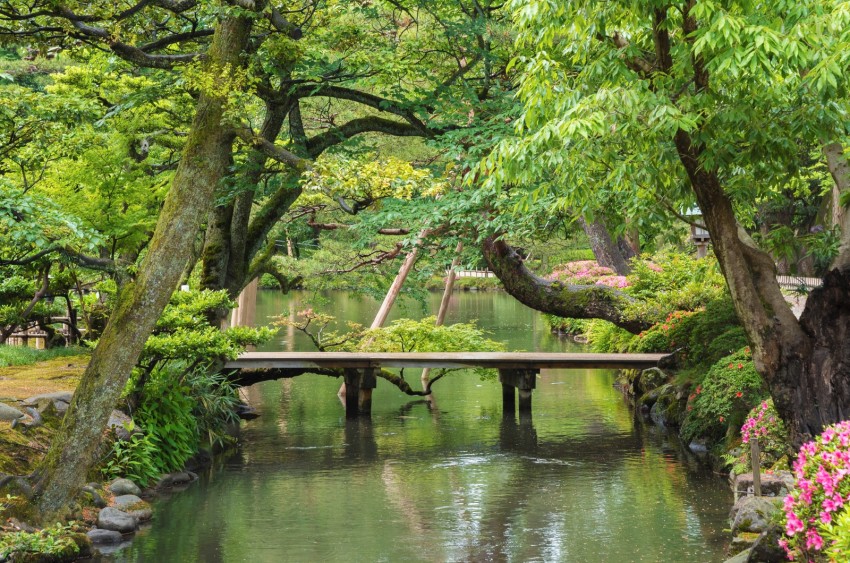In recent months, both the Japanese and international press have extensively covered the Jingu Gaien Redevelopment Project. People have recently protested at the redevelopment site, concerned about the future of this historic urban green space and the potential negative environmental impacts of the project.
The controversy around this project illustrates the sense of attachment that local populations have to gardens and other green spaces as essential parts of our cities. They provide space for citizens to interact with the natural environment and numerous other social, economic and environmental benefits.
In the city of Kanazawa, in Ishikawa Prefecture, residents are also witnesses to the importance of natural urban settings. Here, a model for sustainable urban nature is being promoted around the city's historic gardens. This unique model brings benefits around water, and for artisans, young people and other members of the community.
Water
In Kanazawa, water is a key element of the landscape, coming from the thawing snow of Mount Hakusan.
It feeds the mighty Asano and Sai rivers confined between plateaus as the subsoil aquifers emerge in natural springs. The early inhabitants of Kanazawa understood water as a precious resource. They made it available throughout the city. They built a network of canals to protect the central castle and serve residents daily: washing vegetables, dyeing textiles and irrigating cultivated fields.
They also went a step further in extending the waterways through the city. They altered the topography on their properties and created landscapes of artificial mountains and valleys. They deepened riverbeds, planted trees and created traditional Japanese gardens to welcome water and the wildlife that it brought. Diverse species of fish, turtles, frogs, shellfish, crabs, insects and fireflies have chosen these gardens as their habitats.
Good examples to be found in the city are the Tsuji family garden, Oyama shrine garden and the Hosenji Temple garden.
The arrival of water in Kanazawa's gardens brought biodiversity with it.
Artisans
Kanazawa is a fortress city developed by the Maeda clan at the end of the 16th century. The feudal lord surrounded himself with samurai, merchants and artisans, granting them enough privileges to create a prosperous society and a flourishing vibrant culture.
During this period, the city’s iconic garden, Kenrokuen, was constructed — the first garden in the city connected to an adjacent canal. It exerted a significant influence on all strata of society. City residents reproduce small Kenrokuen in their own homes. Today, many of these owners are artisans creating delicate craftwork that demonstrates the deep links between nature and culture. With their ateliers open to their gardens, they are inspired and their children can grow up in close contact with nature.
The work of these artisans illustrates regular life in harmony with nature. It exemplifies environmental responsibility, shared norms and values focused on preserving local traditional knowledge.
Communities
Like many other cities in Japan, Kanazawa is currently affected by depopulation and the aging of its population. This phenomenon is accelerating the fragmentation and disappearance of nature, abandonment of property and poor maintenance of gardens. It thus threatens the benefits that they provide. Gardens improve the sense of belonging and the social bounds of a great diversity of communities, residents and tourists whose well-being benefits from direct contact with nature.
Communities' interactions with natural features help to increase their harmony, raising awareness of the benefits of kinship with nature. Experiencing for ourselves that nature is our primary source of well-being is crucial. Through volunteering, communities can help to maintain the green commons and implement ecotourism.
Gardens through their communities contribute to the well-being of societies.
Youth
Many of these gardens were conceived by gardeners who developed their skills onsite learning from their masters. In the past, gardeners strove to reproduce the characteristic satoyama (places where nature and people exist in harmony) landscape of the Hokuriku region. It has been carved by heavy snow that undulated the tree trunks, abundant rain that moisturized the moss and scarce daylight that taught them to prune the trees in a particular way.
The functions of these gardens extend far beyond the aesthetic. Today, they are at an environmental crossroads. The gardens are crucial for their ecological benefits, increasing biodiversity and adapting to climate change. For all these reasons, a new sustainable education model centered around them must focus on strengthening links between gardeners and today’s youth who are active in their commitment to ecological concerns.
Young people can reinterpret the traditional values of these gardens and then incorporate the modern visions they have for the future of their cities.
Produced by the UN University Institute for the Advanced Study of Sustainability, a new series of videos illustrates how gardens are the most significant contributors to achieving societies living harmoniously with nature.
The Japanese gardens of Kanazawa offer an inspiring and valuable model to the world for biodiversity, traditional knowledge, well-being and a vision for a sustainable future.
Dr. Juan Pastor-Ivars is a research associate at the United Nations University Institute for the Advanced Study of Sustainability (UNU-IAS) in Kanazawa, Ishikawa Prefecture.
The views expressed in this article are those of the author and do not necessarily reflect the views of the United Nations University.
© Japan Today














No Comment
Login to comment